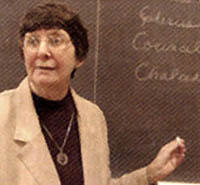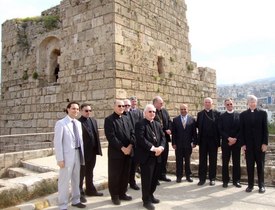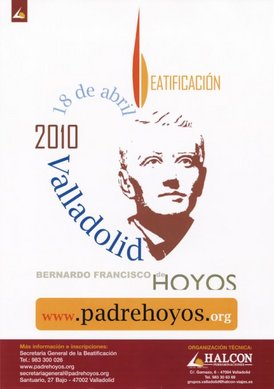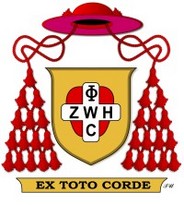Pope Benedict’s 5th anniversary as Supreme Pontiff
 Today is a wonderful day to celebrate: the 5th anniversary of the election of Pope Benedict XVI as the Supreme Pontiff of the Holy Roman Church.
Today is a wonderful day to celebrate: the 5th anniversary of the election of Pope Benedict XVI as the Supreme Pontiff of the Holy Roman Church.
The papacy of Benedict will be marked in history as one that attended to the recovery of the sacred and the beautiful. Recall some of the words he spoke at his inaugural Mass as Pontiff:
“It is really true: as we follow Christ in this mission to be fishers of men, we must bring men and women out of the sea that is salted with so many forms of alienation and onto the land of life, into the light of God. It is really so: the purpose of our lives is to reveal God to men. And only where God is seen does life truly begin. Only when we meet the living God in Christ do we know what life is. We are not some casual and meaningless product of evolution. Each of us is the result of a thought of God. Each of us is willed, each of us is loved, each of us is necessary. There is nothing more beautiful than to be surprised by the Gospel, by the encounter with Christ. There is nothing more beautiful than to know Him and to speak to others of our friendship with Him. The task of the shepherd, the task of the fisher of men, can often seem wearisome. But it is beautiful and wonderful, because it is truly a service to joy, to God’s joy which longs to break into the world.”
Pope Benedict XVI
Homily at the Mass for the Inauguration of the Pontificate, 2005
The Pope meets 8 victims of sexual abuse in Malta: a profound experience
The prominent Italian newspaper, Corriere della Sera, published a beautiful quote of Lawrence Grech, a victim of sexual abuse, who met with Pope Benedict during his pastoral visit to Malta Saturday and Sunday and had a profound experience. Mr. Grech said that he felt liberated, that a great stone lifted after speaking with Benedict. Grech went on to say that after this encounter he was a more convinced Catholic and that this was “the greatest gift after the birth of my daughter.”
Bernardo de Hoyos beatified
Today, in Valladolid, Spain, Father Bernardo de Hoyos (1711-1735) was beatified. I previously mentioned Father de Hoyos on this blog. Here is a précis of Father Adolfo Nicolás’ letter to the Jesuits. The full text of the letter can be read here Bernard de Hoyos letter.pdf
John Paul II and the Development of a “New Feminism”
 The April 2010 issue of Inside the Vatican (18:4) published a special commemorative issue observing the papal death of John Paul II and the papal election of Benedict XVI. The editor asked various people to write their memories of one of the popes. Sister Sara Butler, MSBT, a professor of dogmatic theology at St Joseph’s Seminary -Dunwoodie, New York, offered her thoughts on Pope John Paul’s contribution to feminist thinking. Sister Sara is a published author and a member of the Anglican-Roman Catholic Dialogue and the International Theological Commission. Sister remembers:
The April 2010 issue of Inside the Vatican (18:4) published a special commemorative issue observing the papal death of John Paul II and the papal election of Benedict XVI. The editor asked various people to write their memories of one of the popes. Sister Sara Butler, MSBT, a professor of dogmatic theology at St Joseph’s Seminary -Dunwoodie, New York, offered her thoughts on Pope John Paul’s contribution to feminist thinking. Sister Sara is a published author and a member of the Anglican-Roman Catholic Dialogue and the International Theological Commission. Sister remembers:
Looking back over the papacy of the Servant of God John Paul II, I find myself especially grateful for the initiative he took in addressing the feminist critique. The Pope did this in his Letter to Women (1995), his apostolic letter On the Dignity and Vocation of Women (Mulieris dignitatem, 1988), and his ground-breaking catecheses on the “theology of the body.” He not only acknowledged the positive contributions of feminist scholarship and offered needed clarifications and correctives in response to their objections; he also spelled out his own appreciation of the “genius” of women and took steps to promote their increased participation in the Church and in the social order. Since the Pope’s death, we are already beginning to see the fruits of his recommendation that Catholic women undertake to develop a “new feminism,” consistent with Catholic doctrine (Evangelium vitae, par 99). In my opinion , it is hard to overestimate the contribution Pope John Paul II made to meeting this contemporary challenge.
Tomáš Cardinal Špidlík dead at 91
 The staff of the Centro Aletti with faith in the life-giving power of the Lord’s Resurrection announced the death of Tomáš Cardinal Špidlík Friday, 16 April 2010 at 9 pm.
The staff of the Centro Aletti with faith in the life-giving power of the Lord’s Resurrection announced the death of Tomáš Cardinal Špidlík Friday, 16 April 2010 at 9 pm.
Grail Psalter, Revised –gets Vatican approval
 On November 11, 2008, Abbot Gregory Polan of Conception Abbey received the US bishops’ positive vote for the liturgical use of the Revised Grail Psalter. The Grail Psalter was first published for liturgical use in 1963 and revised by Abbot Gregory and monks of Conception Abbey according to current translation principles including Liturgiam Authenticam (2001)
On November 11, 2008, Abbot Gregory Polan of Conception Abbey received the US bishops’ positive vote for the liturgical use of the Revised Grail Psalter. The Grail Psalter was first published for liturgical use in 1963 and revised by Abbot Gregory and monks of Conception Abbey according to current translation principles including Liturgiam Authenticam (2001)
Recently, the whole project received what is called the “recognitio” from the Congregation for Divine Worship and the Disciple of the Sacraments (the Vatican office deputed by the pope to guide liturgical matters) in a March 19th letter to Bishop Arthur J. Serratelli, Bishop of Paterson and Chairman of the US Bishops’ Committee on Divine Worship.
The reception of Vatican approval of these texts means that future liturgical books will use this translation of the Psalms.
Read Conception Abbey’s press release on receiving the Vatican recognitio for the Revised Grail Psalter, which gives many of the interesting details of the work.
The Catholic Key Blog ran a story on the matter on Thursday, April 15, 2010.
Ut in omnibus glorificetur Deus, That in all things may God be glorified
Blessed Clara Gambacorta
Merciful God, grant us a spirit of prayer and penance.
By following in the footsteps of Blessed Clara may we be worthy to win the
crown she has received in heaven.
Dolan in Syria and Lebanon: the deep sacred roots of the churches, places and people in the story of our redemption
 As bishop, I am told, you are asked to sit on boards and be a voice for causes that you may not have too much interest in or knowledge of. While to the new Archbishop Dolan’s portfolio as the archbishop of New York, he is the chairman of the board of the Catholic Near East Welfare Association (CNEWA) and is learning lots of new and beautiful things about the Church in other parts of the world. He made a recent trip to the Middle East with members of the governing board which opened his eyes to a new reality of what it is like to be an Eastern Christian. John Cardinal Foley, Grand Master of the Equestrian Order of Holy Sepulchre of Jerusalem accompanied the CNEWA board. The archbishop learned the beautiful horizons of the East and the limits thereof.
As bishop, I am told, you are asked to sit on boards and be a voice for causes that you may not have too much interest in or knowledge of. While to the new Archbishop Dolan’s portfolio as the archbishop of New York, he is the chairman of the board of the Catholic Near East Welfare Association (CNEWA) and is learning lots of new and beautiful things about the Church in other parts of the world. He made a recent trip to the Middle East with members of the governing board which opened his eyes to a new reality of what it is like to be an Eastern Christian. John Cardinal Foley, Grand Master of the Equestrian Order of Holy Sepulchre of Jerusalem accompanied the CNEWA board. The archbishop learned the beautiful horizons of the East and the limits thereof.
New Connecticut Episcopal bishop misleading
Reading my hometown newspaper, The New Haven Register, the editors ran a story about Connecticut’s 15th new Episcopal bishop, the Right Reverend Ian T. Douglas regarding his forthcoming ordination. I am sure for many the presence of Nobel peace laureate Archbishop Desmond Tutu will be a big “plus.” But there are aspects of the new bishop’s opportunistic thinking that raises concerns.


